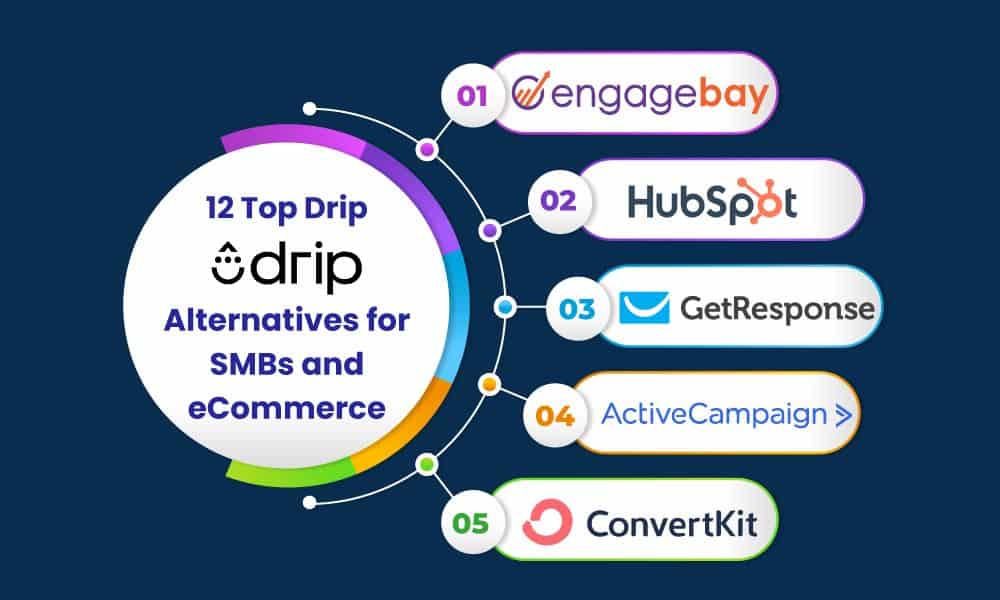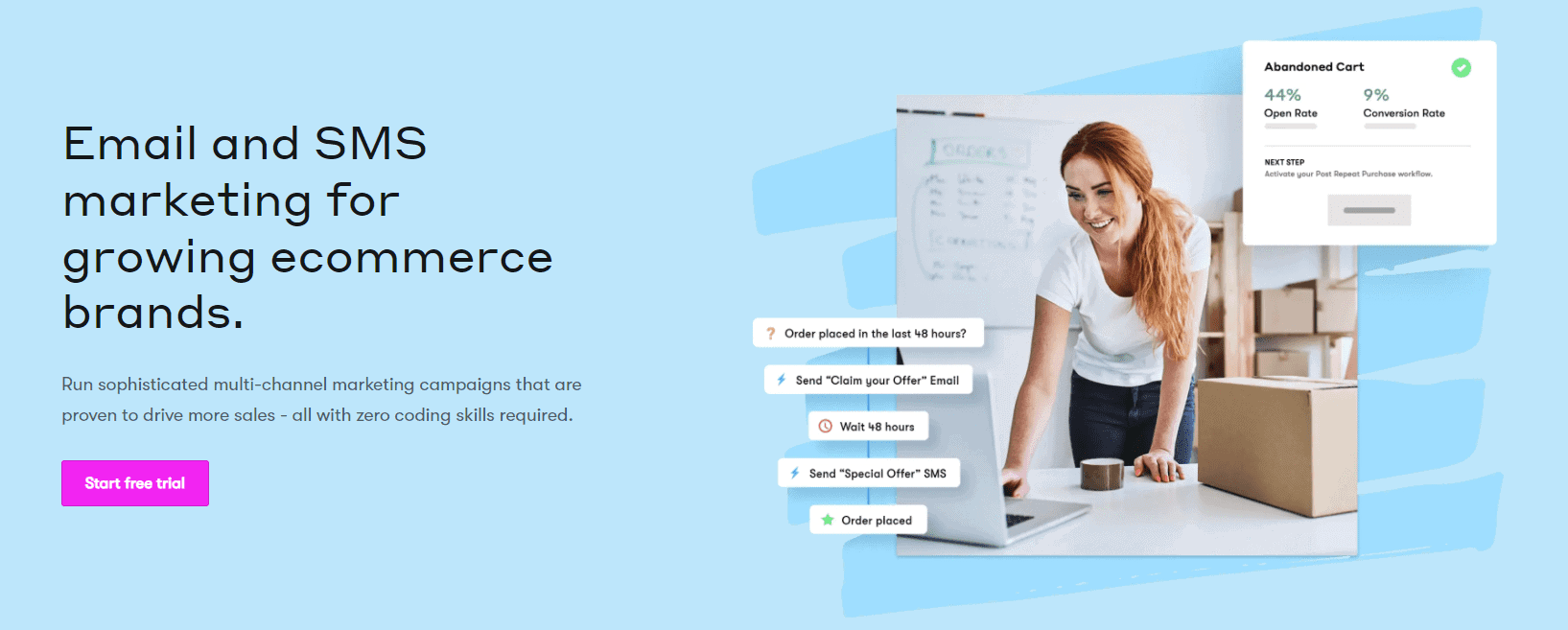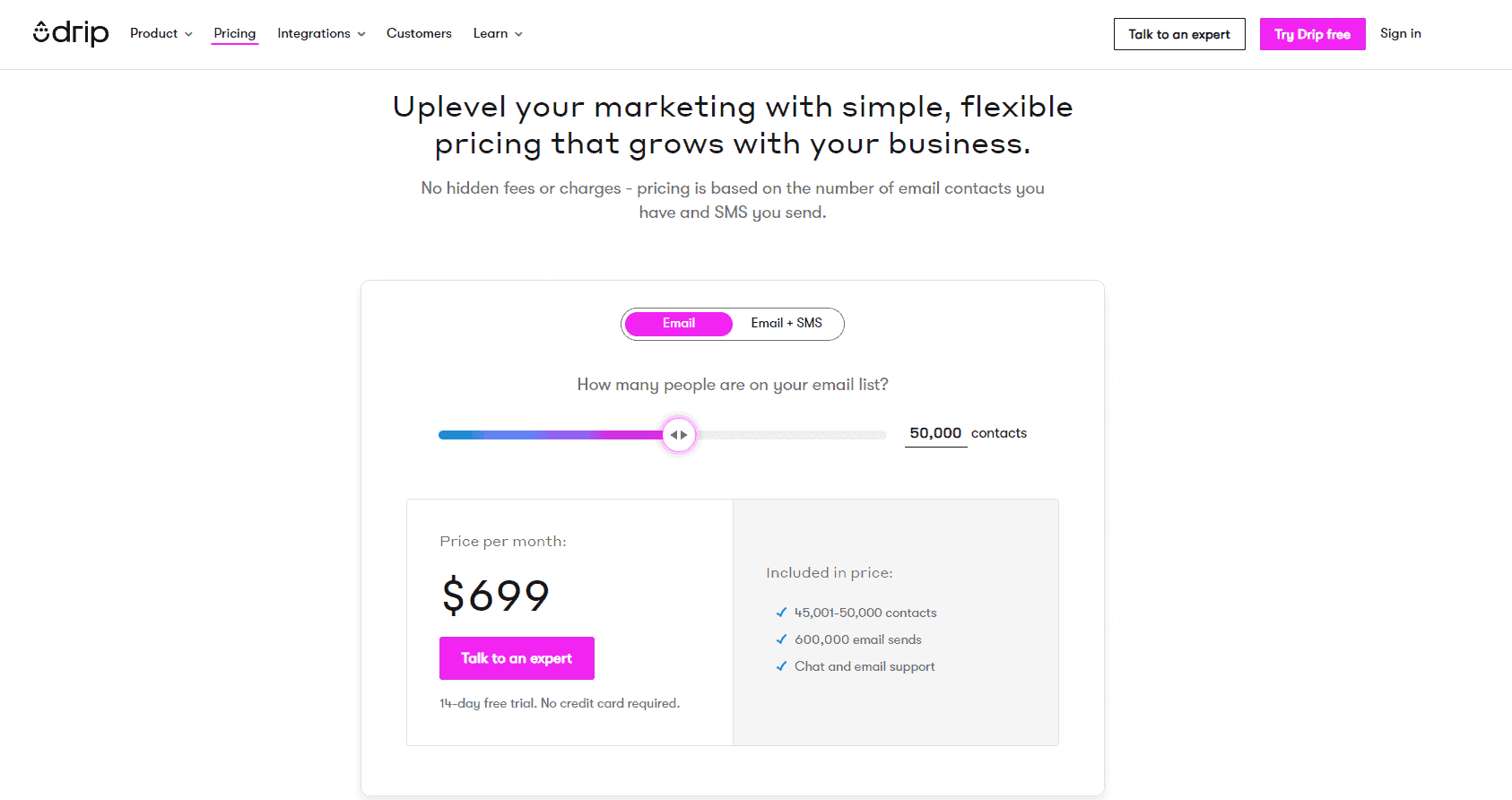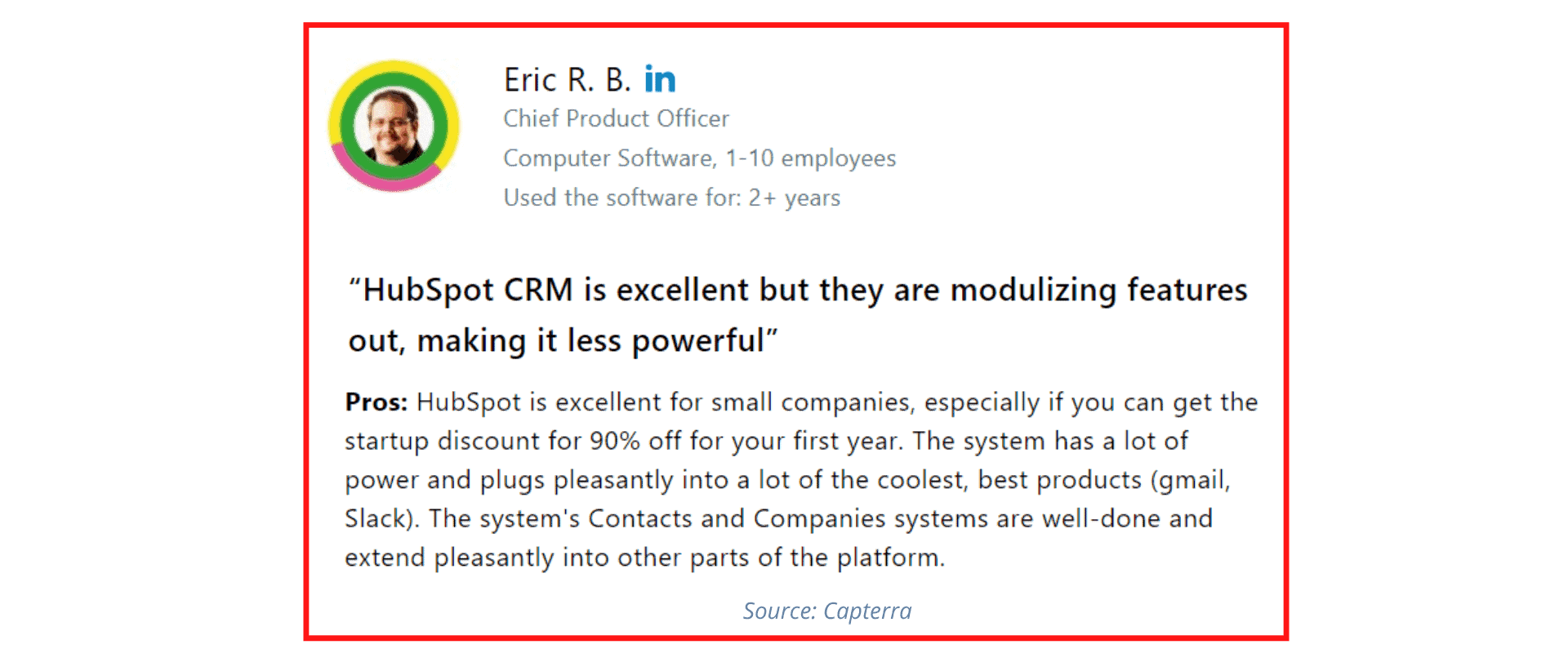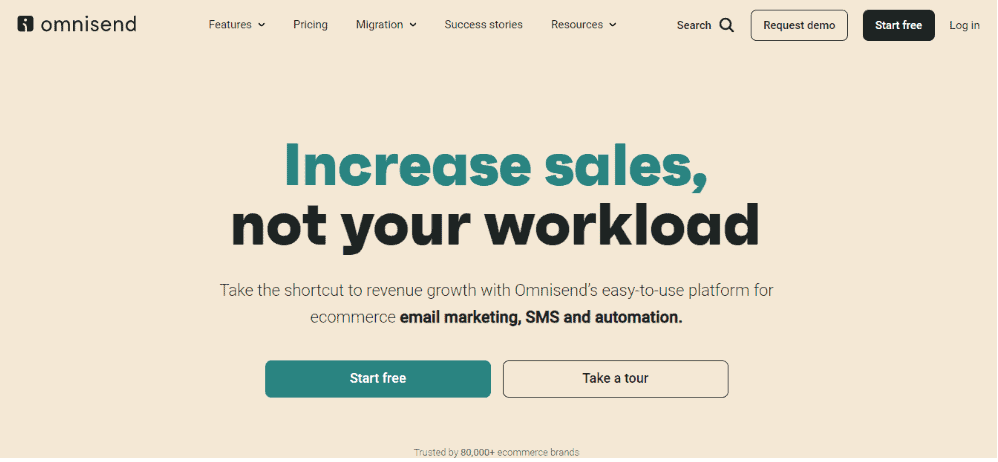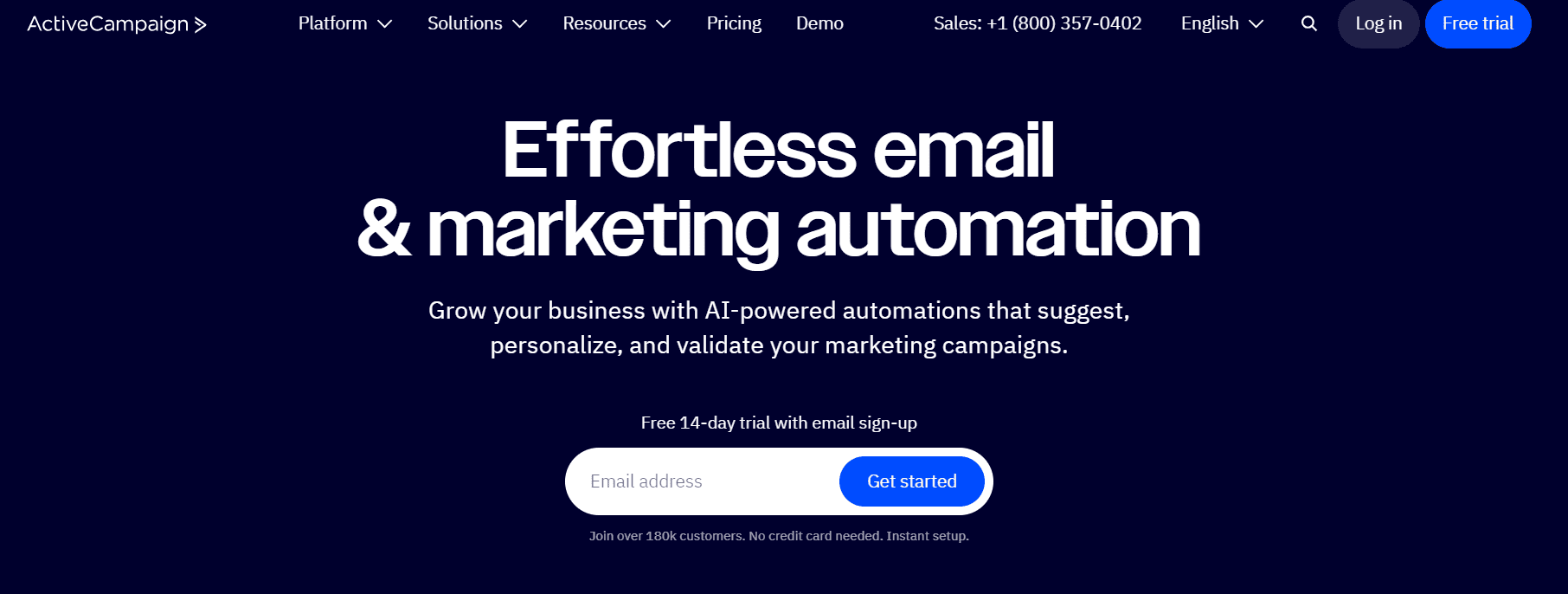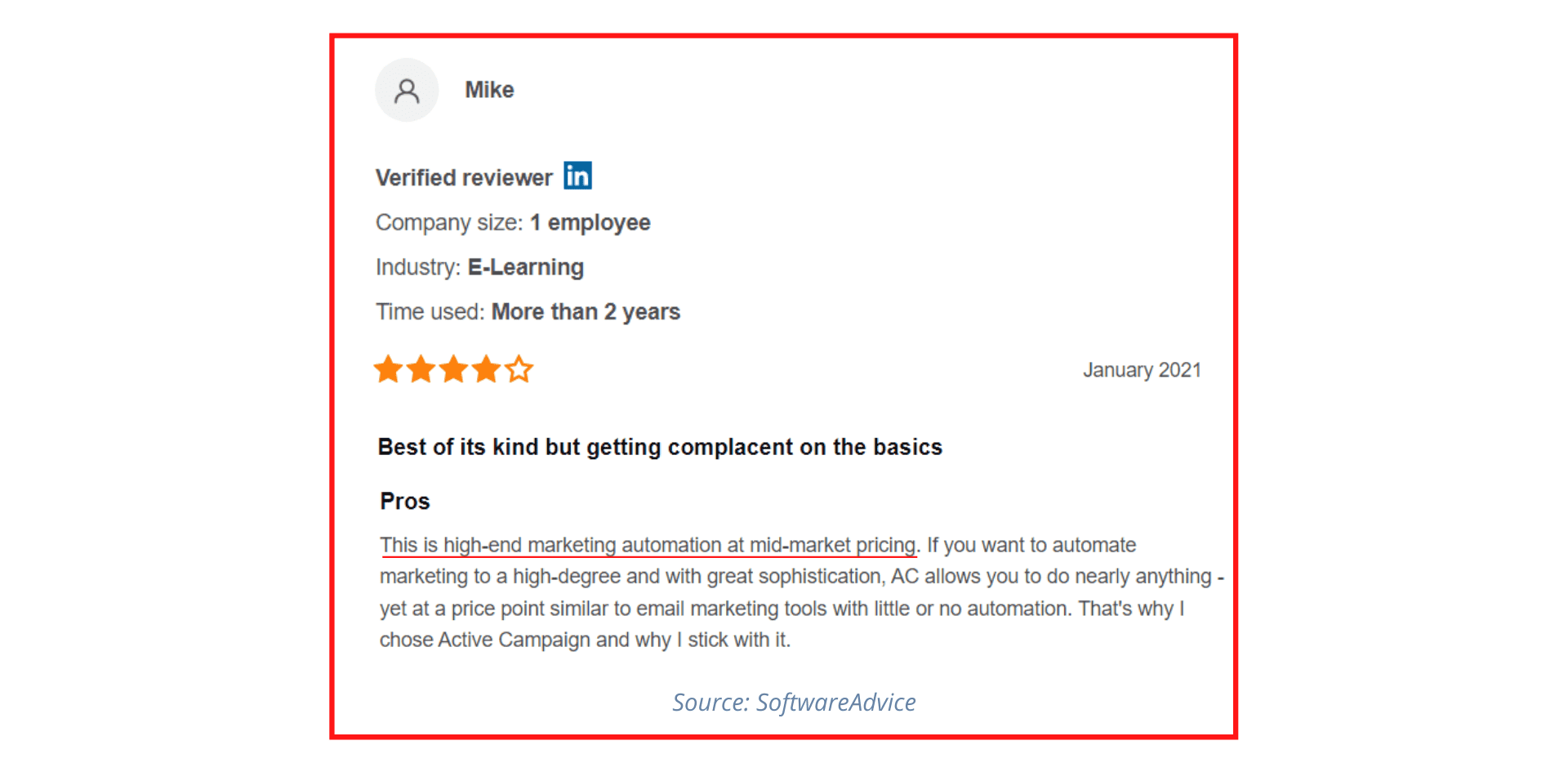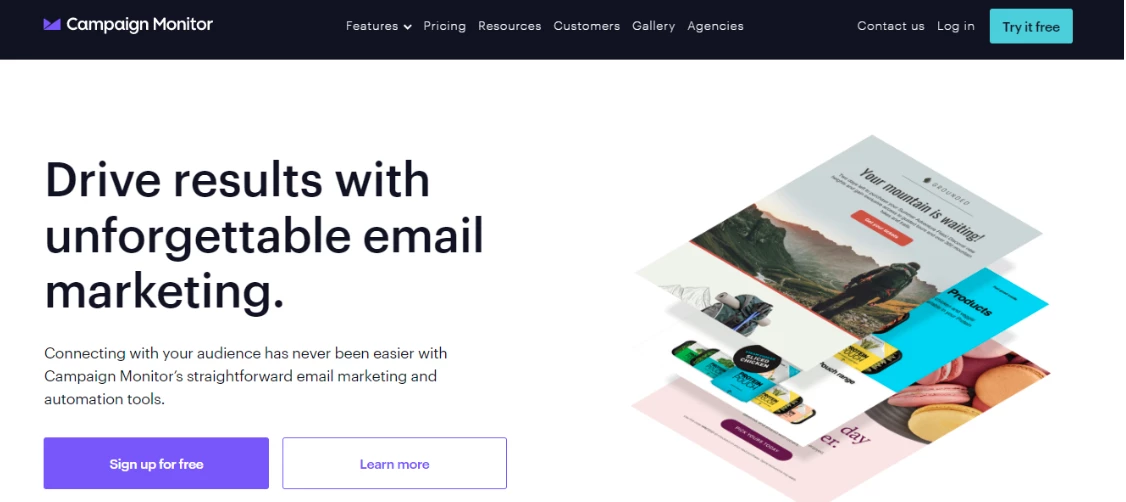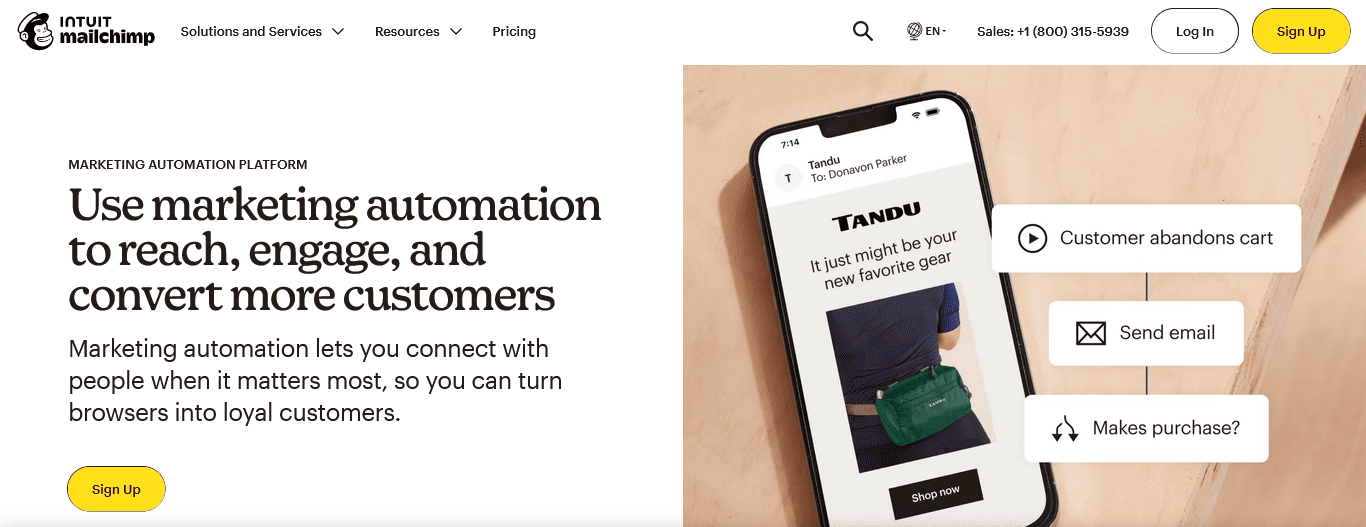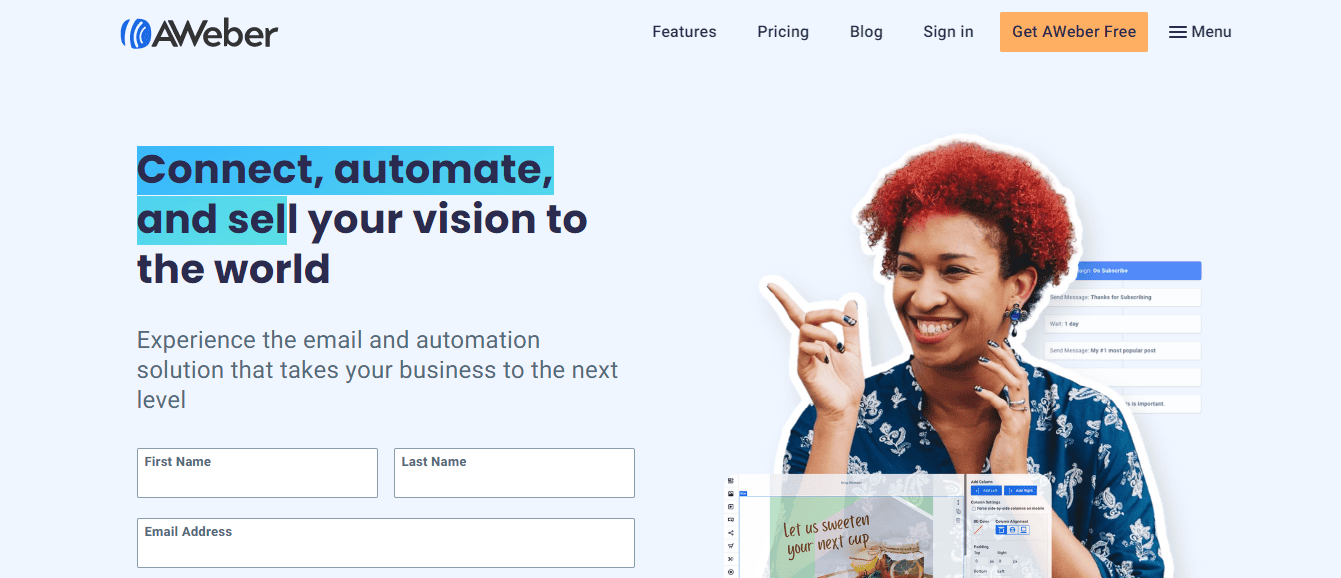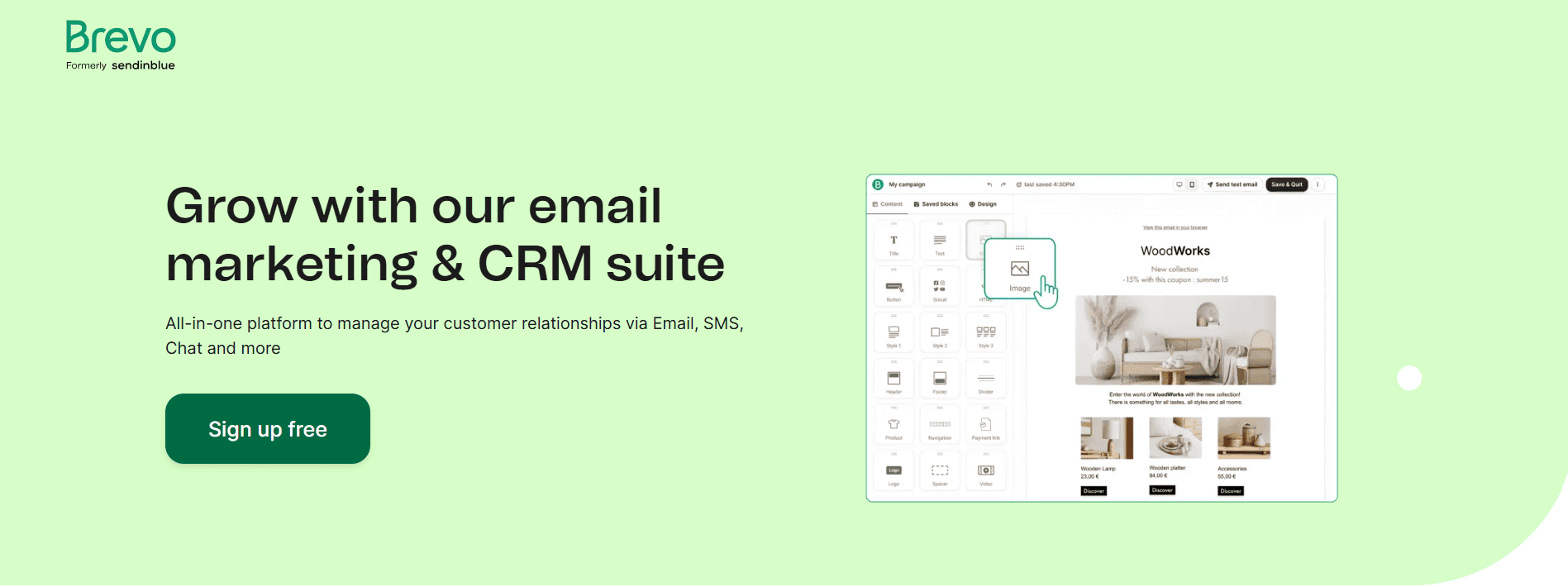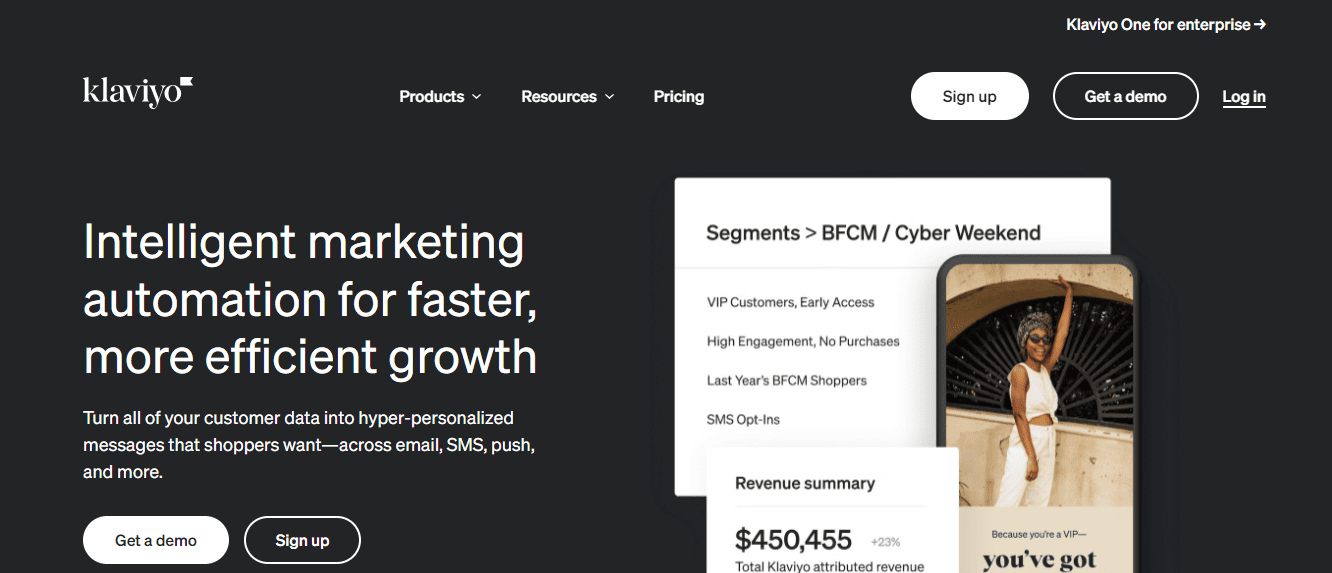Looking for a Drip alternative that fits your budget and offers advanced eCommerce tools? Whether it’s the cost, the lack of features, or the limited customization in your current marketing tool that has you searching for another option, you’re not alone.
The good news? There are several email marketing platforms that not only match Drip’s features and capabilities but also excel in other areas.
In this blog post, we’ll explore 12 of the best Drip alternatives with actionable insights to help you choose the one that best fits your business:
- EngageBay
- HubSpot
- Omnisend
- ActiveCampaign
- Kit (ConvertKit)
- Campaign Monitor
- Mailchimp
- AWeber
- Constant Contact
- Brevo (Sendinblue)
- GetResponse
- Klaviyo
Happy reading!
Table of Contents
Drip Software in a Nutshell
Drip comes with a robust suite of functionalities to help businesses grow their revenue.
It enables you to run and automate proven email and SMS marketing playbooks.
Some of its features include:
- Web forms: It provides lead ads and forms to convert visitors into leads — and feed your segments.
- Segmentation and reports: Using Drip, you can segment your audience on various filters and run your campaigns effectively. Furthermore, you can generate reports to measure various KPIs.
- Email and SMS automation: Drip offers pre-built email templates that can be customized as needed. No wonder Drip is trusted by eCommerce companies like Spice House, Craft, Haute Hijab, and many others.
But then, why should you consider Drip alternatives for your business?
👉 Elevate your email marketing with our free email templates designed to boost engagement and conversions.
Why You Should Consider Drip Alternatives
Drip comes with some power-packed features.
However, it is not a one-size-fits-all solution.
When you implement a marketing automation solution, you expect to get value for money. But even with its basic plan, Drip can be expensive for small businesses and may still not meet your company’s requirements.
Drip is affordable for the first few thousand subscribers, but the cost shoots up as your customer base grows. This is always the problem with sliding scale plans.
Besides, you may not need all of the advanced features that Drip offers.
Drip Pricing
Drip operates on a sliding-scale pricing model. Here’s the pricing breakdown (monthly price):
- $39 for 2,500 contacts
- $69 for 4,000 contacts
- $154 for 10,000 contacts
- $699 for 50,000 contacts
- $1,199 for 100,000 contacts
As you can see, Drip becomes quite expensive as your contact list grows. This may not be feasible for small businesses and startups.
👉 Enhance your campaigns with our free, customizable email templates that drive results.
User Reviews of Drip
Here are more reasons for you to move to another email marketing platform. Take a look at these user reviews, and you’ll find out glaring disadvantages of using the software (don’t get us wrong, Drip has its merits, too):
Expensive: Drip is quite expensive for the features offered, especially when you take into account alternatives that offer the same or even better feature set at lower costs. Take a look:
Email sequencing is missing. Analytics and reports are average. Pricing is expensive as compared to other automation tools.
Limited features for non-eCommerce users: Drip is primarily designed for eCommerce businesses, which may leave other users without advanced tools such as built-in CRM or advanced lead management options.
Learning curve: The platform can be unintuitive for beginners, presenting a steep learning curve. A G2 user mentioned:
I believe one needs to go through tutorials and articles to learn the software, which makes its learning curve complex for beginners, as my team found it difficult at the start.
Support issues: Some users have reported slow or even unhelpful customer service, especially for the basic plans. Here’s what a Drip user said about his experience with customer service:
Tier-one support is quite basic, so I feel that even with chat support (instead of email support), we experience extended wait times to get answers to questions, resolve defects, and address other issues.
The 12 Best Drip Alternatives
That’s why we’ve listed 12 of the best Drip alternatives, from the most affordable to the most comprehensive tools. Take a look at their features, pricing, pros and cons, and make an informed decision.
| Drip alternative | Starting price | Free plan? | Best for | G2 rating |
| EngageBay | $11.04/month | Yes | Small businesses, solopreneurs, startups | 4.6 |
| HubSpot | $18/month | Yes | Medium businesses, enterprises | 4.4 |
| Omnisend | $16/month | Yes | Solopreneurs, SMBs | 4.5 |
| ActiveCampaign | $15/month | No | SMBs, agencies | 4.5 |
| Kit (ConvertKit) | $15/month | Yes | Content creators, small businesses | 4.4 |
| Campaign Monitor | $12/month | No | Medium businesses | 4.1 |
| Mailchimp | $13/month | Yes | SMBs | 4.3 |
| AWeber | $12.50/month | Yes | SMBs | 4.2 |
| Constant Contact | $12/month | No | SMBs, large businesses | 4.0 |
| Brevo (Sendinblue) | $9/month | Yes | Medium businesses | 4.5 |
| GetResponse | $19/month | Yes | SMBs, agencies | 4.2 |
| Klaviyo | $20/month | Yes | SMBs, agencies | 4.2 |
1. EngageBay
The first in our list of Drip alternatives is our own marketing automation tool — EngageBay.
EngageBay offers an all-in-one marketing automation software that fits perfectly into the requirements of small businesses and startups.
| Feature | EngageBay | Drip |
| All-in-one marketing, sales, and support software | ✔ | 𐄂 |
| Sales pipeline | ✔ | 𐄂 |
| Sales automation | ✔ | 𐄂 |
| Omnichannel marketing | ✔ | 𐄂 |
| 360-degree customer view | ✔ | 𐄂 |
| Live chat | ✔ | 𐄂 |
| Helpdesk | ✔ | 𐄂 |
| Appointment scheduling | ✔ | 𐄂 |
| Web analytics | ✔ | 𐄂 |
Features
EngageBay has categorized all its marketing tools into three categories: Marketing Bay, CRM & Sales Bay, and Service Bay.
Marketing Bay
EngageBay offers an integrated marketing platform that provides you with a unified platform for all your marketing leads.
With EngageBay’s 360-degree view, you can send engaging emails to nurture leads, build beautiful landing pages, and convert leads into customers easily. Additionally, explore our email templates to enhance your email campaigns and boost engagement rates.
While both EngageBay and Drip offer robust marketing automation functionalities, EngageBay is simpler to use.
Besides, it offers a myriad of automation features at a more affordable price.
CRM & Sales Bay
EngageBay also offers a free sales CRM software that helps you streamline your sales processes and stay organized.
In EngageBay, setting up sales automation is pretty simple and doesn’t require extensive training. With EngageBay’s free CRM (Customer Relationship Management) suite, you can organize all your email contacts, track deals, manage your pipeline, and boost your revenue with little effort.
Furthermore, the drag-and-drop task and deal management features let you quickly visualize and update your deals.
Service Bay
EngageBay support modules offer world-class customer service tools — ranging from a help desk to a live chat widget that can remain active on all your website pages. As part of the CRM suite, the live chat software and the help desk are entirely free!
On the other hand, Drip does not offer customer support modules, live chat functionality, or a helpdesk.
Developer API
EngageBay’s API is available in Rest, Java,.Net, Javascript, and PHP.
Reports
EngageBay offers a more holistic reporting module when compared to Drip. It offers you deep and meaningful insights so that you can understand your company’s performance, weaknesses, and pain points at a glance.
You also get traffic analytics that shows you how your visitors got to your pages, their time spent on each page, links clicked, bounces, and conversion rates.
1. Pros
- Easy to use and implement
- Offers a free CRM suite
- Free onboarding and migration services for a seamless setup
- All-in-one software eliminates the need for multiple platforms
- Rich set of templates for emails, landing pages, and lead capture forms
Cons
- Not enough third-party integrations yet.
Pricing
EngageBay has four pricing plans:
- Free: This plan is free for up to 15 users and offers 500 contacts, 1,000 branded emails, email marketing, autoresponders, email broadcasts, sequences, landing pages, CRM, and LiveChat.
- Basic: This plan costs $14.99 a month for 1,000 contacts, 3,000 branded emails, email templates, SMS marketing, Social Suite, tag management, web pop-ups, and so much more.
- Growth: The most popular plan costs $64.99 a month for 10,000 contacts, 25,000 branded emails, advanced marketing automation, broadcast and landing page A/B testing, custom domain, call records, service automation, proposals, and push notifications.
- Pro: Costs $119.99 a month for unlimited contacts, 50,000 branded emails, web analytics, custom reporting, uptime SLA, a dedicated account manager, proposal analytics, goals, and more.
EngageBay also offers a 10% discount on annual plans and a 20% discount on biennial plans.
👉 Boost your email marketing campaigns with EngageBay’s customizable email templates tailored for engagement and success.
2. HubSpot
The next in our Drip alternatives list is HubSpot, founded by two MIT students back in 2006.
Since then, it has grown to serve over 95,000 customers globally, helping businesses acquire customers, close deals, and offer customer support.
HubSpot offers a full-fledged marketing software that goes beyond automating email marketing.
It aims to help you scale your business by standardizing your workflow and automating repetitive tasks. You also get a comprehensive social media management tool to help you capture leads and nurture them across social channels.
Features
Let’s take a look at HubSpot’s features.
All-in-One Marketing Tools
This all-in-one inbound marketing software comes with a comprehensive suite of tools.
HubSpot offers tools to help you blog, create landing pages, manage leads, and analyze customer data.
Automated Email Campaigns
HubSpot aims to help businesses generate and nurture leads by automating email marketing campaigns.
It allows you to choose from dozens of triggers and actions to create multi-step automations that eliminate the need for micromanagement.
Personalized Workflows
HubSpot lets you create personalized workflows — because, let’s face it: gone are the days of mass untailored marketing. It has a visual editor to create a simple follow-up campaign or multi-stage journey drip campaigns.
Further, you can use advanced contact list segmentation to detect and target your audiences automatically.
Pros
- Robust functionalities
- In-depth training materials
- Mobile interface
- Rich dashboard
- Advanced tools for enterprises
Cons
- Pay for additional technical support
- Mandatory, expensive orientation and setup fees.
Pricing
Hubspot offers three plans: Starter, Professional, and Enterprise:
- Starter: The Starter plan comes with the HubSpot Service Hub Starter, HubSpot Sales Hub Starter, HubSpot Marketing Hub Starter, and HubSpot CRM and starts at $18 a month. This plan offers limited features.
- Professional: The Professional plan combines the Service Hub Professional, Sales Hub Professional, Marketing Hub Professional, and HubSpot CRM. This plan starts at $800 a month and offers a bunch of advanced features.
- Enterprise: This includes the Service Hub Enterprise, Sales Hub Enterprise, Marketing Hub Enterprise, and HubSpot CRM. Though it unlocks all the features, the pricing starts at a whopping $3,600 a month!
Enhance Your Email Marketing
Want to make your emails more impactful? Check out our beautiful, easy-to-customize recruitment and email templates. Designed to boost engagement, these templates from EngageBay will help your emails stand out. Just customize the images, headings, and CTAs for your brand, and hit send in a few minutes!
3. Omnisend
For eCommerce brands seeking to improve their email marketing campaigns, Omnisend works best.
It combines your email efforts with SMS marketing, which results in a higher conversion rate. Unlike Drip, it offers a free plan for businesses or individuals just starting out.
Features
Below are the key tools provided by Omnisend.
Email Marketing
Using Omnisend, you can create personalized email campaigns by segmenting your contacts, create dynamic content blocks using the email drag-and-drop builder, and optimize your campaigns with tools such as A/B testing and campaign booster.
Automations
Omnisend offers advanced automation capabilities, with plenty of pre-built flows to choose from, such as “welcome automation”, “abandoned cart automation”, “happy birthday automation”, etc.
Audience Sync for Ads
An in-built audience sync feature helps you target your customers based on existing segments on Facebook and Google, using ads that are customized to their needs.
Push Notifications
The push notifications feature provides instant updates to customers about abandoned shopping carts, product recommendations based on browsing history, updates on order and shipping status, and information on special offers and discounts.
Signup Forms
You can capture relevant customer information through built-in web signup form templates, identify abandoning visitors, and increase your SMS subscriber list.
Further, you can also track the signup to understand how to increase your contact base.
Pros

- Many professional templates to choose from, and is easily customizable
- Its user-friendly interface makes it easy to navigate through the platform
- Its cost-effectiveness allows businesses of all sizes to capitalize on their email marketing campaign.
Cons

- Automatic branding needs improvement
- A few users didn’t find the email template library useful and preferred creating their own
Pricing
With Omnisend, there are three plans to choose from: Free, Standard, and Pro.
- Free: The Free Plan is ideal for startups and new businesses. It includes up to 250 contacts, pre-built automation and workflows, unlimited segmentation, A/B testing, and 24/7 email and chat support.
- Standard: It starts from $16 per month and includes all the tools under the Free Plan plus unlimited web push notifications, Facebook custom audiences, and automation splits.
- Pro: The Pro Plan works best for those looking to adopt SMS marketing. Starting from $59 per month, the plan boasts advanced reporting, 24/7 priority support, personalized recommendations, audience growth, and an image editor as some of its key features.
4. ActiveCampaign
ActiveCampaign is another Drip alternative option that offers email marketing, automation, and customer relationship management.
It aims to help businesses enhance their customer experience. ActiveCampaign can be used by eCommerce businesses and companies, B2B platforms, and brands going digital.
Features
Let’s take a look at ActiveCampaign features.
Email Marketing
ActiveCampaign allows you to send personalized emails to your prospects and leads.
You can segment your email lists based on various filters and send out dynamic messages to your prospects.
Marketing Automation
ActiveCampaign offers powerful marketing automation tools, including contact management, automation workflow features, tagging, drip campaigns, and advanced segmentation.
You can also set up a welcome email series or create an automated workflow without any hassle.
Smart CRM
A smart CRM software keeps all the customer data organized in a single database.
This is where you can easily keep track of all your leads, update deals, and always follow up at the right time. You have a detailed timeline of each customer so that you can offer better services.
With ActiveCampaign, you can improve the quality of your leads through lead scoring, task management, note creation, customer touchpoints, and more.
Website Messaging
ActiveCampaign offers customer messaging tools to help you reach out to your audiences across various platforms. The purpose is to help businesses build meaningful connections with customers.
Its features include engagement tracking, product recommendation, feedback system, and LiveChat support.
Pros
- Reliable online support
- Seamless third-party integration
- Autoresponder options
Cons
- Cluttered dashboard
Pricing
ActiveCampaign has four paid plans to choose from: Lite, Plus, Pro, and Enterprise.
- Lite: Starts at $15/month for 1,000 contacts and offers marketing automation, email marketing, drag-and-drop email builder, segmentation, and campaign reporting.
- Plus: Starts at $49/month for 1,000 contacts and adds landing pages, conditional content, contact scoring, automation map, and SMS marketing.
- Pro: This plan starts at $79/month for 1,000 contacts and features predictive sending, split automation, attribution reporting, and website personalization.
- Enterprise: Starts at $145/month for 1,000 contacts and adds a bunch of advanced tools. These include social data enrichment, custom domain, reporting, and free design services.
👉 Optimize your marketing efforts with our email templates designed for efficiency and impact.
5. Kit (ConvertKit)
Kit (formerly ConvertKit) is an email marketing automation platform designed specifically for bloggers, content creators, and authors.
It aims to grow customer relationships by understanding your audience through segmentation, analytics, automation, and a host of other tools, making this one of the best Drip alternatives for content creators.
Features
Let’s take a look at Kit’s features.
Segmentation and Tagging
Through Kit’s segmentation, you can place your audience into various buckets based on various factors — and even add your own custom filters.
Besides, its tagging feature lets you send hyper-targeted email newsletters and broadcasts.
Email Designer
Kit (ConvertKit) offers designers tools to create and launch beautiful, visually appealing, and content-centric email campaigns. Through built-in personalization, your emails can turn heads and improve your conversion figures.
You can also create your own templates without having to code. The mobile-responsive design means your content will look as you intend on both desktops and mobile devices.
Landing Pages
Kit lets you create landing pages with ease — no coding required.
However, it still offers custom CSS as an option for more control. You can add stylesheets to customize your landing pages in a way that reflects your brand identity. Just like with the email designer, the landing page templates are fully responsive. You can see their previews for different devices.
Automation
Kit’s automation tool is relatively easy to use.
You can schedule your email campaign and send out targeted content to your audiences. It enables you to create a powerful automated funnel for higher conversions.
Commerce
Kit’s eCommerce features lets users sell products through the web in just a few steps — the perfect tool for content creators, artists, and bloggers.
You don’t have to create a complicated eCommerce website for selling. Besides, you can set up one-time purchases for products like an eBook. There is no limit to the number of products you can sell.
Pros
- Ease of use
- Easy WordPress integration
- Visual automation builder
- Live chat and email support
Cons
- Limited A/B testing
Pricing
Kit (ConvertKit) prices its services into three plans: Newsletter, Creator, and Creator Pro.
- Newsletter: This plan is absolutely free to use and offers email broadcasts, unlimited landing pages, community support, and selling options for digital products.
- Creator: Starts at $15 a month for 300 subscribers and adds automated funnels, automated sequences, live chat and email support, and free migration.
- Creator Pro: Starts at $29 a month for 300 contacts and unlocks everything, including advanced reporting, subscriber scoring, newsletter referral system, and Facebook custom audiences.
6. Campaign Monitor
Campaign Monitor is an excellent Drip alternative for those looking to boost conversions using both email and SMS marketing.
With its drag-and-drop tool, easy template customization, and visual journey designer, Campaign Monitor is an ideal platform for startups and large businesses alike.
Features
Let us look at some of Campaign Monitor’s key features.
Customizable Email Templates
With a drag-and-drop HTML email template builder, you can create visually engaging yet impactful email newsletters within minutes.
What’s more, you can also lock template sections for your teams, ensuring consistency in branding.
Marketing Automation
The email marketing automation tool helps you create automated email sequences that can be sent to customers based on certain triggers or actions.
Using Campaign Monitor, you can create email series such as welcome emails, special offers, birthday discounts, VIP offers, and reminders.
Email Analytics
The reporting and analytics tool allows you to track campaign performance in real-time using features such as A/B testing for email subject lines, spam testing, and generating data on metrics such as open rates, clickthrough rates, bounce rates, and content optimization.
SMS Marketing
The SMS marketing feature helps you create a marketing campaign on a single dashboard within minutes.
Further, you can create personalized messages based on customer behavior to drive clickthrough rates and get instant results using real-time reporting.
Pros
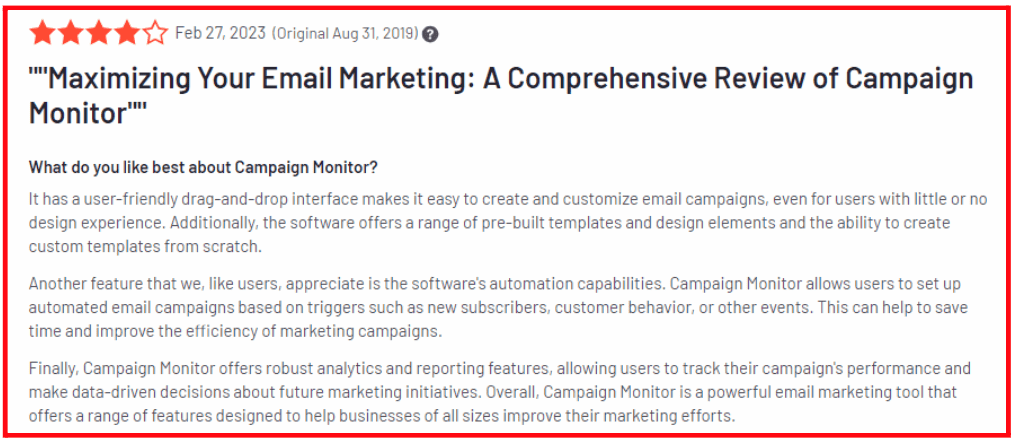
- A user-friendly drag-and-drop interface makes it easy to create customized email campaigns
- It boasts in-built email templates that can be customized from scratch
- Helps users quickly set up automated email campaigns based on triggers such as consumer behavior, essential events, and new subscribers
- Allows businesses to track campaign performance in real-time, enabling them to undertake crucial decisions and improve marketing decisions
Cons

- Pricing can be expensive, particularly for companies with large mailing lists or growing email marketing needs
- More third-party integrations are required
Pricing
Campaign Monitor offers four pricing plans: Lite, Unlimited, and Premier.
- Lite: The Basic Plan starts from $12 per month for 500 contacts and includes tools such as a drag-and-drop email builder, customized email library, branded templates, A/B testing, and email verification.
- Essentials: Starting from $29 per month for 500 contacts, the Essentials plan boasts advanced features such as a countdown timer, time zone for sending emails, two-factor authentication, and template sharing.
- Premier: The Premier Plan costs $159 per month for 500 contacts and comes with email section locking, phone support, deliverability support, send time optimization, and advanced link tracking.
7. Mailchimp
One of the most popular platforms, Mailchimp, is ideal for those new to email marketing.
It boasts a wide range of tools, including marketing automation and CRM, along with over 300+ integrations with apps such as Shopify, Google Analytics, Zapier, WooCommerce, and so on.
Features
Below are some of Mailchimp’s key features.
Marketing CRM
Mailchimp’s marketing CRM helps maintain all your contact data on a single dashboard, segment your audience based on tags, track consumer behavior, and get actionable insights in real-time.
Creative Assistant
Mailchimp’s AI-powered creative assistant provides customized designs for your brands, such as logos and images.
All you need to do is import your brand’s assets to a brand kit, where the creative assistant will build a customized design for your company.
Smart Marketing Recommendations
Using the smart marketing recommendations feature, you can get personalized suggestions on how to optimize email content.
Further, it can dynamically customize it for multiple contacts, predict customer lifetime value, and get suggestions to create attention-catching email subject lines.
Automated Customer Journeys
This tool helps you nurture customer relationships by curating messages that are relevant to their needs and visually building automated experiences that can be customized to business goals and consumer behaviors.
Pros

- Easy-to-use interface
- The platform makes it convenient to compose and save emails that can be integrated with Google and social media for publishing
- Keeps mailing lists updated by identifying and eliminating subscribers that do not engage
Cons

- The pre-built email templates could be customized further
- At times, it can be difficult to edit the mailing list
Pricing
Mailchimp has four pricing models: Free, Essentials, Standard, and Pro.
- Free: It is Mailchimp’s forever-free plan that provides up to 500 contacts, pre-built email templates, over 300+ integrations, basic reporting and analytics tools, and in-built forms and landing pages.
- Essentials: This plan starts from $13 per month and comes with up to 500 contacts, 24/7 email and chat support, assisted onboarding, A/B testing, and email scheduling.
- Standard: Under the Standard Plan, you can get custom-coded templates, send time optimizer, content optimization, 500 contacts, and a campaign manager for $20 per month.
- Pro: The Premium Plan costs a whopping $350 per month for 10,000 contacts and has advanced tools such as multivariate testing, comparative reporting, and advanced segmentation.
8. AWeber
Another affordable email marketing platform is AWeber, which acts as an all-in-one platform for generating leads and converting them into paying customers.
With tools like email marketing, landing page builders, and email automation, AWeber helps you rapidly expand your mailing list and create content that drives sales.
Features
Here are some of AWeber’s key features.
Built-in Design Templates
AWeber boasts a wide range of built-in email templates that can be used on any occasion.
What’s more, you can create images on AWeber using Canva or access high-quality stock images for free.
Email Autoresponders
Using a drag-and-drop builder, you can create email autoresponders to welcome new clients as well as send bulk emails based on certain user actions and triggers.
Dynamic Content Personalization
Based on purchase history and customer behavior, you can segment your contacts and send them emails with personalized content relevant to their preferences.
Email Deliverability
Using tools like A/B and spam testing, you can be assured that emails sent through AWeber will land in the right user’s inbox.
Pros
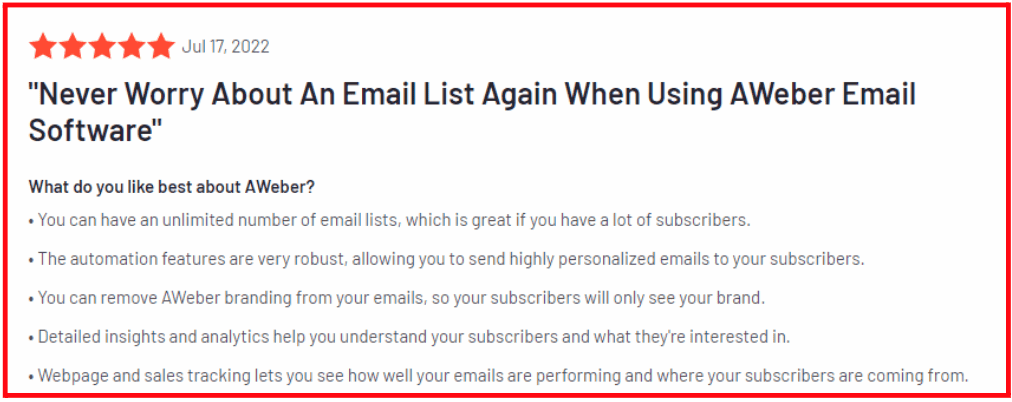
- Helps you create an infinite number of mailing lists
- Allows you to remove the AWeber branding from emails and only highlight your brand
- Provides in-depth reporting and analytics on what content subscribers are interested in
- Using the automation feature, you can send highly personalized emails to your customers
Cons

- The interface can be confusing and difficult to navigate for first-time users
- The split testing feature is only provided for the paid plans
- At times, it can be difficult to set up various automation features
Pricing
AWeber provides four pricing categories: Free, Lite, Plus, and Unlimited.
- Free: AWeber’s forever-free plan provides up to 500 subscribers, a single mailing list, basic templates, and basic customer support.
- Lite: Under the Lite Plan, users can get unlimited subscribers, 24/7 support, advanced message analytics, and three email automation. It starts from $12.50 per month.
- Plus: Starting at $20 per month, the Plus Plan includes unlimited mailing lists, unlimited landing pages, unlimited automation tools, priority support, and advanced reporting and analytics tools.
- Unlimited: The Unlimited Plan costs $899 per month and provides you with a full template library, advanced landing page features, personalized account management, and sales tracking.
👉 Boost your campaigns with our customizable email templates that drive results.
9. Constant Contact
Constant Contact is an email marketing platform that helps you expand your clientele by leveraging the power of social media and emails on a single platform.
One more thing that makes Constant Contact a preferred choice is that it offers Android and iPhone apps, allowing you to access your marketing tools and reports on the go.
Features
Below is a list of Constant Contact’s important features.
Email Marketing
With over 100+ pre-built branded templates, you can instantly create effective email marketing campaigns that boost sales.
Social Media Marketing
Using Constant Contact, you can create ads for different social media channels, respond to comments and messages, and track the performance of your campaigns, all on a single dashboard.
List Growth Tools
With Constant Contact, you can grow your subscriber list fast using in-built landing pages and SMS marketing campaigns.
What’s more, audience insights help you determine what’s working and optimize accordingly.
Pros
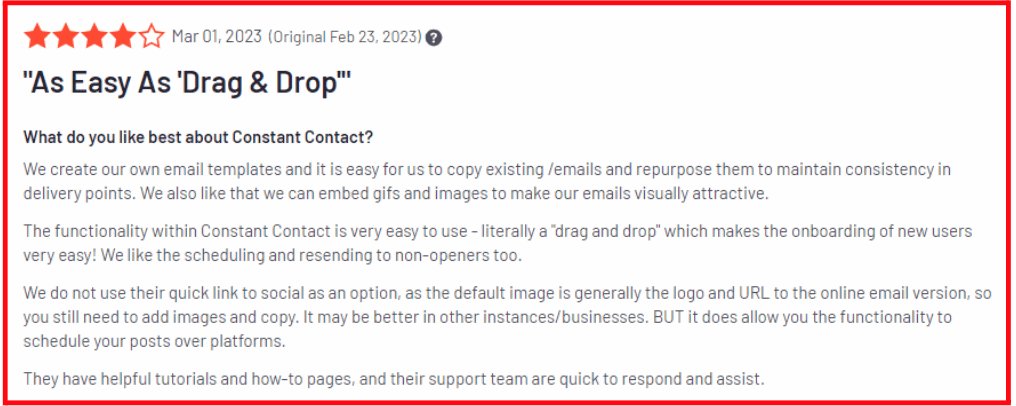
- Constant Contact allows you to embed GIFs and images in emails to boost engagement
- Quick and efficient customer support
- Allows you to create email templates from scratch and repurpose existing emails to maintain consistency
Cons

- Extracting relevant data can be difficult
- Limited comparisons between emails are provided
- Clearing or updating existing segmentation lists is not intuitive or user-friendly
Pricing
Constant Contact has three pricing options: Lite, Standard, and Premium.
- Lite: The Core Plan starts from $12 per month for 500 contacts and includes over 100+ email templates, integrations with Shopify, Canva, Etsy, and WooCommerce, engagement reporting metrics, built-in signup forms, and live chat and phone support.
- Standard: Costing $35 per month for 500 contacts, the Standard plan comes with dynamic content personalization, list growth tools, automated communication tools, in-depth reporting, and auto-generated customer segmentation.
- Premium: Starts at $80/month for custom automation, custom segmentation, revenue reporting, and SEO recommendations.
10. Brevo (Sendinblue)
If you are looking to build a brand reputation quickly, it is best to choose an email marketing platform that boasts omnichannel marketing features.
Brevo (Sendinblue) fits right into this criteria, making it one of the most preferred Drip competitors. It boasts all digital marketing tools in one place, making it easy for businesses to grow and nurture customer relationships.
Features
Let us look at some of the tools offered by Brevo (Sendinblue).
Marketing Platform
Under the marketing platform, you can find tools such as email marketing, WhatsApp campaigns, SMS marketing, built-in landing pages, pre-built signup forms, Facebook Ads, and marketing automation tools.
Conversation Management
It helps you manage conversations across multiple platforms in a single place and connect with your clients on any platform, all from one dashboard.
Sales CRM
The Sales CRM provided by Brevo (Sendinblue) lets you track and manage all sales pipelines in real time, monitor deals as they progress through the sales funnel, identify areas of improvement, and automate administrative tasks in your sales workflow.
Transactional Emails
The transactional email feature ensures that your emails are delivered to the right inbox.
With tools such as a dedicated IP address, SMTP relay, and email API, you can be assured that emails sent don’t land in the spam or promotions folder.
Pros

- Pre-assembled layouts and drag-and-drop tools make it easy to create email campaigns
- Provides real-time data on open rates, clickthrough rates, and conversions
- Allows you to track relevant metrics and customize email content
Cons

- The number of pre-built email templates is limited
- At times, selecting the wrong email template or layout can result in your emails landing in the spam or promotion folders
Pricing
With Brevo (Sendinblue), you can choose among four plans: Free, Starter, Business, and Enterprise.
- Free: The Free Plan provides unlimited contacts, along with 300 daily email sends, customizable email templates, a drag-and-drop editor, transactional emails, and SMS and WhatsApp campaigns.
- Starter: The Starter Plan costs $9 per month for 5,000 emails, basic reporting and analytics, and email support.
- Business: Starting at $18 per month, the Business Plan includes tools such as marketing automation, A/B testing, advanced statistics, multi-user access, send time optimization, and phone support.
- Enterprise: This is a customized plan that comes with advanced features such as enterprise-grade security, sub-account management, tailored onboarding, and personalized support.
11. GetResponse
GetResponse is an email marketing tool designed to simplify and automate email campaigns.
Its suite of marketing features includes lead generation, customer engagement, and online sales management.
Features
Let us look at the key features of GetResponse.
Marketing Automation
GetResponse’s marketing automation helps you deliver personalized and meaningful emails to your customers. It sends out automated product recommendations based on the customers’ purchase history and other data.
Furthermore, it optimizes and automates workflows, tracks website visitors, and captures leads.
Email Marketing
With GetResponse drag-and-drop email creator, you can easily design and send emails in just a few clicks.
You can schedule your emails and set triggers to send emails automatically. Before sending, you can preview designs for their responsiveness. GetResponse lets you add GIFs and free stock photos to your emails directly from the platform.
Landing Pages
You can easily create landing pages without any prior coding experience.
It comes with ready-made, mobile-responsive templates from which you can choose. With the built-in image editor, you can personalize pages to match your brand style.
Paid Ads
GetResponse helps you run targeted ad campaigns to grow your subscribers’ list. You can target your existing subscribers with paid ads or even locate people with interests similar to your existing contacts.
Webinars
GetResponse offers an easy-to-use webinar builder and scheduler.
You can further customize your webinar URL and enable easy registration.
Pros
- User friendly
- Comprehensive reporting feature
- Integrates with Google Analytics
- A/B testing
Cons
- No phone support
Pricing
GetResponse offers five pricing plans: Free, Email Marketing, Marketing Automation, E-Commerce Marketing, and GetResponse Max.
- Free: This plan is free forever and offers 500 contacts, a landing page, custom domain, a website builder, and signup forms.
- Email Marketing: Starts at $19 a month for 1,000 contacts and offers autoresponders, basic segmentation, email scheduling, and more.
- Marketing Automation: Starts at $59 a month for 1,000 contacts and features marketing automation, webinars, advanced segmentation, sales funnels, and contact scoring.
- E-Commerce Marketing: You get paid webinars, web push notifications, unlimited funnels, eCommerce features, and so much more. The plan is priced at $119/month for 1,000 contacts.
- GetResponse MAX: Starts at $1,099/month for a dedicated IP address, SSO, SMS marketing, transactional emails, unlimited users, and priority support.
12. Klaviyo
Klaviyo is an email and SMS marketing platform designed specifically for eCommerce businesses.
The robust features help businesses create personalized customer experiences, drive engagement, and increase revenue.
Features
Let’s look at the key features of Klaviyo:
Marketing automation
Klaviyo’s automation tools let you create personalized customer journeys with ease. The platform leverages customer data to send targeted emails and SMS messages based on behavior, purchase history, and preferences.
Email marketing
Klaviyo offers a drag-and-drop editor that makes designing professional emails simple. You can also segment your audience based on various criteria like purchase behavior, browsing activity, and location data. It even offers advanced A/B testing to optimize email campaigns.
SMS marketing
Klaviyo integrates SMS marketing with email, allowing you to send personalized text messages to your customers. This means you can create multichannel marketing campaigns through Klaviyo’s automation feature.
Integration
Klaviyo integrates seamlessly with popular eCommerce platforms like Shopify, WooCommerce, and BigCommerce, and other third-party applications.
Pros
- Built specifically for eCommerce businesses
- Excellent segmentation capabilities
- Integrated SMS marketing features
Cons
- Pricing increases significantly as your contact list grows
- Limited features for non-eCommerce users
Pricing
Klaviyo offers three plans:
- Free: The Free plan offers 250 active profiles, mobile push notifications, courses, and other basic features.
- Email: This plan starts at $20/month for 500 active profiles, predictive analytics, Email AI, email and chat support, and more.
- Email+SMS: Starts at $20/month for 500 active profiles and 150 SMS credits, multichannel attribution, A/B testing, and advanced analytics.
Wrap Up
Drip is a powerful marketing automation software, but it isn’t the only option available. If you are looking for the best Drip alternative, the 11 marketing automation software mentioned in this blog are all great.
Every software has its own pros and cons.
While EngageBay is pocket-friendly for small businesses and comes with a robust suite of functionalities, ActiveCampaign can be an excellent choice for integration with other third-party applications. For content creators, Convertkit is a great choice.
But there’s a caveat.
These Drip alternatives (except for EngageBay) operate on a sliding-scale pricing model. While it can be convenient for you — it doesn’t show the complete picture.
For example, let’s compare the higher-end plans for each alternative.
HubSpot costs $800 a month for 2,000 contacts. For 32,000 contacts, the pricing almost doubles to $3,050 a month.
The same goes for GetResponse. While the professional plan costs $99 a month for 1,000 contacts, the price increases to $255 for 25,000 contacts.
ActiveCampaign’s Professional plan costs $149 a month for 500 contacts but more than triples to $549 a month for 25,000 contacts.
Kit is no different. The plan costs $279 a month for 25,000 contacts for the Creator Pro plan (which only costs $59 a month for 1,000 subscribers)
What about EngageBay?
With EngageBay, you get the Pro plan with unlimited contacts for just $119 a month — and no hidden fees. For example, you must pay a mandatory setup fee while subscribing to HubSpot; there is no such thing with EngageBay.
Plus, you get unlimited contacts and thousands of emails!
Sign up now for free — no credit card or commitments required. You can also book a 30-minute demo session with our experts at a time of your convenience, and we’ll give you a tour of the product.
We hope that this article will help you make the right choice for your business.
👉 Have you tried our email templates? Share your experience in the comments below, and let us know how they worked for your campaigns!
